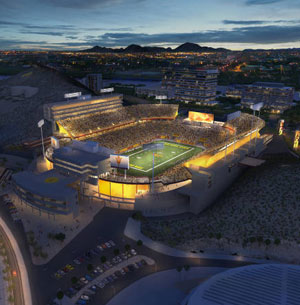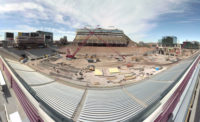On Jan. 14, Arizona State University made official that will invest $210 million to renovate and rebuild its aging Sun Devil Stadium in Tempe.


The proposed plan will completely renovate the facility while preserving Tillman Tunnel and retaining the stadium in its iconic setting between the Tempe/Hayden buttes. The football team will continue to use the stadium throughout the period of renovation which is anticipated to be complete in 2017.
The demolition project has been awarded to Hunt Construction, according to assistant athletic director Rocky Harris. He said a winning bid has not yet been named for the renovations that will follow. Crews began removing the bleacher seats in the north end zone — sections 220 to 228 — this weekend. The upper concourse, loge and lower bowl seating will not be impacted through this process, Harris said. Demolition of the North end-zone is scheduled to begin in February.
The project will create more legroom, seats, and benches with backs, add new higher quality restrooms, install a premiere video board and sound system, and bring the venue into ADA compliance, among other planned implementations.
One of the important goals of the project is to maintain the look and feel of the venue while completely reshaping the amenities and infrastructure to enhance the overall experience. The university's athletics department took feedback through surveys, focus groups, and fan input to create the latest rendering of the project.
“We need to upgrade the whole set of facilities here [at Sun Devil Stadium] to have us be competitive at the level we want to compete,” said President of the ASU Foundation Rick Shangraw in a release provided by ASU.
Based on input from the community, and in light of the additional cost, a $132 million shade canopy has been removed from the project blueprint. After this proposal was floated a few years ago, alumni and other fans complained it would restrict views of fireworks after the home team scored a touchdown.
The last major renovation to Sun Devil Stadium came in 1988 when 1,700 seats were added, which brought the facility to its current capacity of 71,706. The scheduled removal of the north end zone, which was announced in the fall of 2013, will take place next month and is not part of the renovation project.
Sun Devil Stadium, which is built into the naturally prominent geological structures on site, is a prominent landmark in the area, built in 1958. The price of remedying the structural issues and the minimal ADA issues is estimated to be about $120 million. Currently, about a $1 million per year is spent on repairs to the stadium.
“I always get asked questions on my commitment to rebuild Sun Devil Stadium. I am standing here tonight to say, ‘The University is 100 percent invested in the renovation of Sun Devil Stadium’,” said President Michael Crow during presentation to donors Tuesday night, according to a release made available by ASU.


Post a comment to this article
Report Abusive Comment